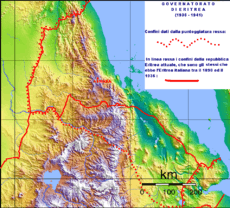Italian Massawa
-_Hafen_-_Annemarie_Schwarzenbach_-_SLA-Schwarzenbach-A-5-23-151.jpg)
Italian Massawa was the colonial period of Massawa -the main port of Eritrea- when was under Italian rule.[1]
History
.jpg)
Eritrean city of Massawa was a colony of the Kingdom of Italy since the late 1890s until 1947, when Italy surrendered all the colonies in the peace treaty after World War II. In those seven decades the city grew from a small village to a cosmopolitan city of nearly 25,000 inhabitants that was the main port or Eritrea.
The port was the main of Italian Eritrea and was greatly improved in the 1930s, in order to allow a military navy base and also a service of civilian ocean liners (like Vulcania).
The port was also connected to Asmara by a railway still existing: construction of this rail line began from the Red Sea port city of Massawa in 1887, heading towards the capital city of Asmara. The "Decauville" railway was the first built, from Massaua to Saati, just 27 km (17 mi).[2] Progress was slow, thanks to the long climb up the mountains to the high plateau of inland Eritrea, and the substantial civil engineering works required; the line reached Asmara in 1911.
This Eritrean Railway was built by the Italians next to a modern highway in order to efficiently connect Massawa and Asmara, the main cities of Italian Eritrea.
There was also a link with the Asmara-Massawa Cableway: it was a cableway (or "ropeway").[3] The Eritrean Ropeway, completed in 1937, ran 71.8 km (44.6 mi) from the south end of Asmara until the city-port of Massawa.
The Eritrean Ropeway, completed in 1937, ran 71.8 km from near Massawa to the south end of Asmara. This was the longest cableway ever. Ralph Reinhold
In 1940, Massawa had nearly 20,000 inhabitants, of which almost 6,000 were Italians: the city was improved with an architectural plan similar to the one in Asmara, with a commercial and industrial area.[4]
During World War II Massawa was the homeport for the Red Sea Flotilla of the Italian Royal Navy. When the city fell during the East African Campaign, a large number of Italian and German ships were sunk in an attempt to block use of Massawa's harbor.
See also
Notes
- ↑ "Massaua italiana". dadfeatured.blogspot.com. Retrieved 2018-08-13.
- ↑ Railway Massaua-Saati, built in 1887-1888 (in italian) Archived 12 October 2013 at the Wayback Machine.
- ↑ "TELEFERICA MASSAUA ASMARA www.funivie.org :: Il sito italiano sugli impianti a fune (The Eritrean cableway)". funivie.org (in Italian). Retrieved 2018-08-13.
- ↑ Vittorio Santoianni (2008-05-22). "Il Razionalismo nelle colonie italiane 1928-1943 | La "nuova architettura" delle Terre d'Oltremare" (PDF). Università degli Studi di Napoli “Federico II” - Facoltà di Architettura. Retrieved 2018-08-11.
Bibliography
- Bandini, Franco. Gli italiani in Africa, storia delle guerre coloniali 1882–1943. Longanesi. Milano, 1971.
- Negash, Tekeste. Italian colonialism in Eritrea 1882–1941 (Politics, Praxis and Impact). Uppsala University. Uppsala, 1987.
